Vancouver << van KOO vuhr >> is the most populous city in British Columbia and the busiest port in Canada. It also ranks as one of Canada’s largest cities. The people who live in the Vancouver metropolitan area make up about half of the entire population of British Columbia. The city is the province’s major center of commerce, culture, industry, and transportation.
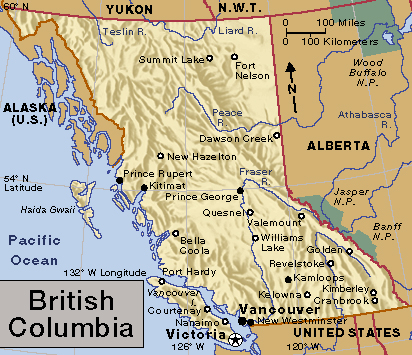
Vancouver lies in southwestern British Columbia, about 25 miles (40 kilometers) north of the Canadian-United States border. The city’s chief asset is its natural harbor in Burrard Inlet. The harbor is connected with the Pacific Ocean by English Bay, the Strait of Georgia, and Juan de Fuca Strait. Ships can use the port the year around because the harbor’s waters never freeze. The port handles nearly all of Canada’s trade with Japan and other Asian nations. Vancouver is often called Canada’s Gateway to the Pacific.
The first permanent European settlement at what is now Vancouver grew up near a sawmill built in 1865. Rich timber resources helped the settlement become a bustling lumber town. In 1884, the Canadian Pacific Railway chose the site as the western terminal of Canada’s first transcontinental railroad. William Van Horne, the railroad’s general manager, named the town for Captain George Vancouver, a British explorer who had sailed into Burrard Inlet in 1792.
Greater Vancouver
Vancouver stands on the southern shore of Burrard Inlet. The city lies in a beautiful setting, near the Coast Mountains and the ocean. The protective mountains and the warm winds from the Pacific help provide a mild climate for a city so far north.
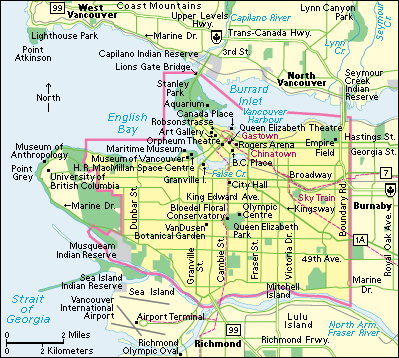
The Vancouver metropolitan area is called Greater Vancouver. It is Canada’s third largest metropolitan area. Only the Montreal and Toronto metropolitan areas have larger populations.
The city
of Vancouver lies on two ridges separated partly by a shallow inlet called False Creek. Stanley Park, an important recreational area, is on the shorter, northern ridge. Farther south and east on this ridge stands downtown Vancouver. Rows of high-rise apartment buildings extend eastward from an area called the West End, through downtown Vancouver, to Yaletown on False Creek. The southern ridge includes the East End, a large section of single-family homes.
The intersection of Granville and Georgia streets is the heart of downtown Vancouver. The 30-story Toronto Dominion Bank Tower rises over the intersection. It stands in Pacific Centre, a complex that also has a department store and an underground shopping center. The Living Shangri-La building on Georgia Street is the city’s tallest building. It rises 659 feet (201 meters).
Several other areas of the city have special characteristics. Robson Street—also known as Robsonstrasse, its name in German—once featured European import stores. Today, it is a major center for tourists. Vancouver’s original Chinatown is on Pender Street. It is one of the largest Chinese communities in North America. Thousands of people of Chinese descent live nearby. Another concentration of Chinese restaurants and Asian-style malls has developed in the neighboring city of Richmond. A distinctive South Asian commercial area called the Punjabi Market occupies the south end of Vancouver’s Main Street.
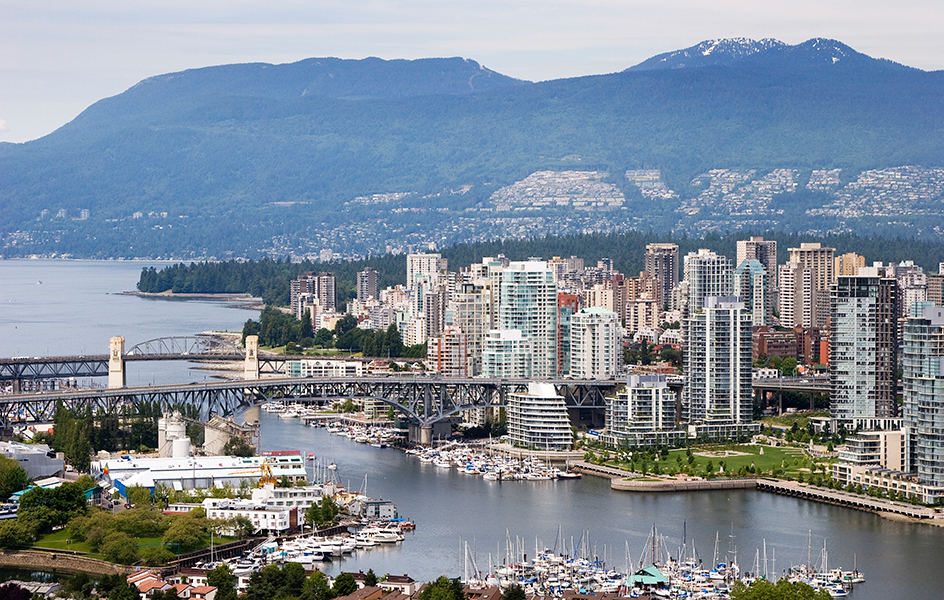
Gastown, the original center of Vancouver, consists of a few redeveloped blocks just north of Chinatown. Gastown’s old brick buildings and cobblestone streets recall the city’s early days. This area has many tourist shops, art galleries, and furniture stores.
The False Creek waterfront, once Vancouver’s center of industry, has undergone redevelopment into a pleasant residential area. A community of town houses and apartments lines the south shore of False Creek, and gleaming towers rise along the north shore. Nearby is Granville Island, a popular tourist shopping destination with markets, boutiques, and restaurants.
The metropolitan area.
The majestic Coast Mountains, including two snow-capped peaks called the Lions, rise north of Vancouver. Point Grey, a peninsula, juts into the Strait of Georgia at the west end of the city. The flat, fertile lands at the mouth of the Fraser River basin spread south of Vancouver.
The suburb of Surrey ranks as British Columbia’s second most populous city, after Vancouver. Other suburbs include Burnaby, Coquitlam, Delta, North Vancouver, Port Coquitlam, Port Moody, Richmond, and West Vancouver.
People
About three-fifths of Vancouver’s people were born in Canada. People of British ancestry make up the largest group. A majority of immigrants to Vancouver are Asian.
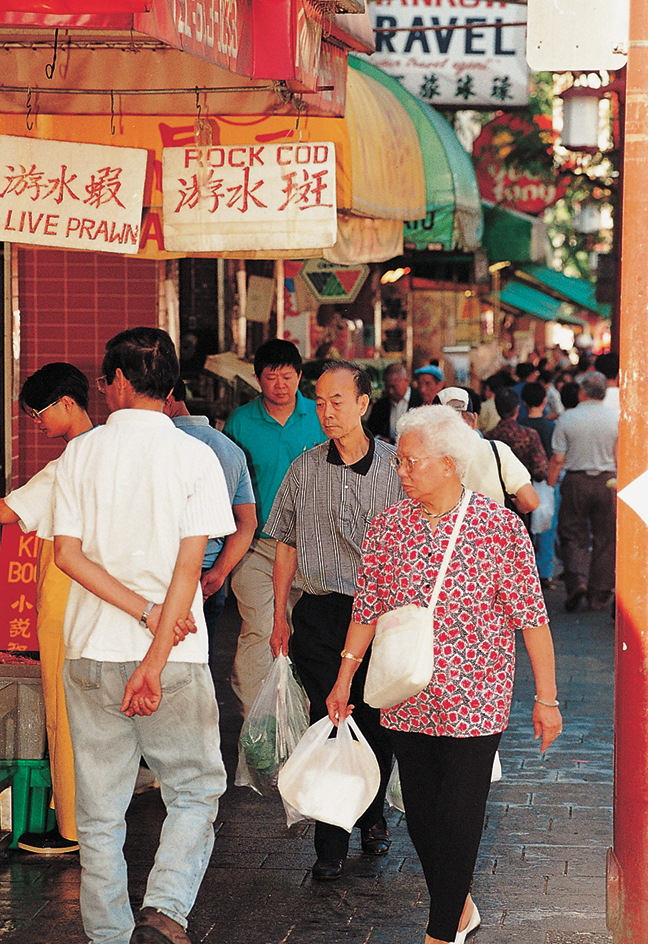
Vancouver’s mild climate has helped make the city a popular retirement center. The climate also attracts large numbers of young people from other parts of Canada. Poverty and illegal drugs are major problems in Vancouver, especially among people who live in run-down buildings just east of downtown.
Economy
Trade and finance.
The Port of Vancouver is Canada’s busiest port, handling millions of tons of cargo annually. It serves as the main center for the distribution of goods shipped between Canada and Asia. The port is also the center of an important northern coastal trade. Numerous steamship lines serve Vancouver.
Vancouver is the largest wholesale and retail trading center of western Canada. Tens of thousands of workers in Greater Vancouver are employed by wholesale and retail companies. The tourist industry—boosted by the area’s skiing facilities—ranks among Vancouver’s fastest-growing sources of employment. Vancouver has more banks, loan companies, and other financial institutions than any other western Canadian city.
Transportation.
Vancouver serves as the western terminal of Canada’s two transcontinental railroads, the Canadian National Railway and the Canadian Pacific Railway. VIA Rail Canada, a passenger railroad system funded by the Canadian government, links Vancouver to other cities in British Columbia and to eastern Canada. Amtrak, a railroad system partly financed by the United States government, connects Vancouver with U.S. cities.
Vancouver International Airport is Canada’s second busiest airport. Only the airport at Toronto serves more passengers. Major Canadian, Asian, European, and U.S. airlines use Vancouver’s airport for flights to Asia.
TransLink, a regional transportation authority, manages bus, train, and ferry systems in Vancouver. The rapid transit SkyTrain links downtown Vancouver with the suburbs of Burnaby, New Westminster, Richmond, and Surrey. The West Coast Express commuter rail line extends about 42 miles (68 kilometers) between downtown Vancouver and the municipality of Mission in the Fraser Valley. Ferry lines connect Vancouver with Vancouver Island.
The Lions Gate Bridge spans the entrance to Burrard Inlet. It is 1,550 feet (472 meters) long and links Stanley Park and West Vancouver. Farther up Burrard Inlet, the Ironworkers Memorial Second Narrows Crossing connects Vancouver with North Vancouver. The Trans-Canada Highway connects Vancouver and other Canadian cities.
Industry.
Compared with other North American metropolitan areas, Greater Vancouver has a small, diverse manufacturing sector. Professional, scientific, and technical services that deal with the export of knowledge have gained economic importance. Plants that process fish and wood operate along the Fraser River, south of Vancouver. Other activities include metal fabricating, the making of paper and related products, and the manufacture of petroleum and coal products. Industries based on processing natural resources have caused considerable environmental damage to the area. The waters of Burrard Inlet, for example, are heavily polluted.
Communication.
Vancouver has two major daily newspapers, The Province and The Vancouver Sun. The city also has a number of weekly and semiweekly community newspapers. A number of television and radio stations serve the city. The Canadian Broadcasting Corporation/Radio-Canada (CBC/Radio-Canada) has its regional headquarters in Vancouver
Education
Schools.
A school board supervises Vancouver’s public schools. Vancouver also has a number of church-supported and private schools. The University of British Columbia, on Point Grey, is one of the largest universities in Canada. It lies just west of Vancouver’s western city boundary. Simon Fraser University is in Burnaby, just east of Vancouver’s city limits.
Libraries.
The Vancouver Public Library system includes a central library in the downtown area and branches throughout the city. The University of British Columbia Library has special collections of materials relating to western Canadian history and Chinese immigration to Canada.
Cultural life and recreation
The arts.
The Vancouver Opera performs in the Queen Elizabeth Theatre. The Arts Club Theatre Company presents stage performances. The Vancouver Symphony Orchestra performs at the Orpheum Theatre. The Chan Centre for the Performing Arts at the University of British Columbia has superb acoustics (conditions for listening to music). The Vancouver Art Gallery features paintings by European and Canadian artists.
Museums.
The Museum of Vancouver and the H. R. MacMillan Space Centre form part of a cultural center at the mouth of False Creek. The museum includes exhibits on the settlement of western Canada. The space center features an observatory and a planetarium. Nearby, the Vancouver Maritime Museum displays the Arctic exploring ship St. Roch. This vessel was the first to sail through the Northwest Passage from both the west and the east, between 1940 and 1944. The Museum of Anthropology, one of the finest museums of its kind, is at the University of British Columbia.
Parks.
Vancouver has dozens of parks. Stanley Park occupies 1,000 acres (400 hectares) and is among the largest city parks in Canada. It includes the Vancouver Aquarium, one of the finest marine centers in the world and the largest in Canada. Stanley Park is also known for its flower gardens. Queen Elizabeth Park includes an arboretum and the Bloedel Floral Conservatory. VanDusen Botanical Garden, in the heart of Vancouver, has a large plant collection.
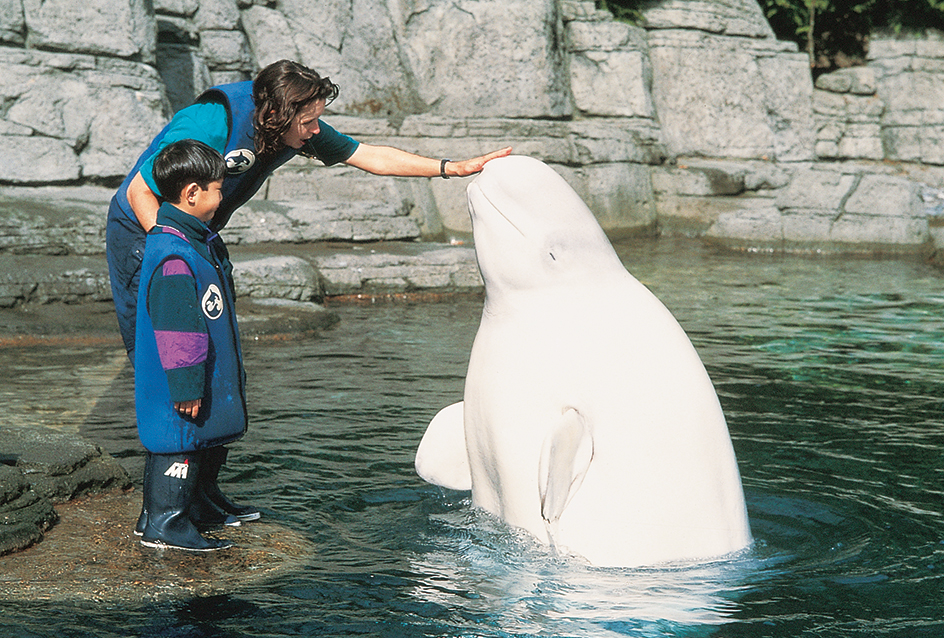
Vancouver’s mild climate makes it attractive for many outdoor activities, including fishing, golf, and tennis. The Vancouver area also has many fine beaches and skiing facilities. The Pacific National Exhibition attracts many visitors in late August and early September every year. The exhibition is western Canada’s largest fair. It includes agricultural and industrial displays and many kinds of entertainment.
Sports.
The city is the home of two major professional sports teams. The British Columbia Lions play in the Canadian Football League. The Vancouver Canucks compete in the National Hockey League.
Government
Vancouver has a council-manager form of government. The voters elect the mayor and the 10 other members of the City Council to four-year terms. Property taxes furnish most of the city government’s revenue. But these and other taxes do not provide enough money to pay for public services and needed improvements. As a result, Vancouver depends on funds from the federal and provincial governments to meet its expenses.
Other problems in Vancouver include air and water pollution and a shortage of low-rent housing. City leaders are also concerned about the increasing rate of construction on land that may be needed for parks or for other recreational use.
History
Salish Indians lived in the Vancouver area for more than 2,000 years before European explorers arrived. In 1791, José María Narváez, a Spanish explorer, became the first European to see the area. The English explorer George Vancouver entered Burrard Inlet in 1792.
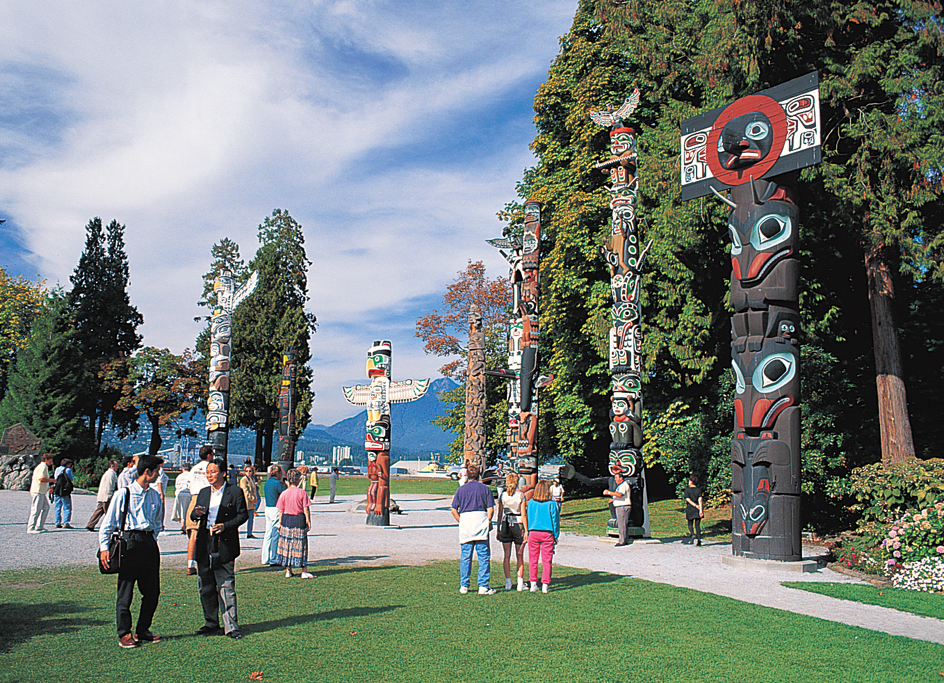
The settlement that became Vancouver grew up around a sawmill that Edward Stamp, a British sea captain and businessman, began to build in 1865. The mill, later known as Hastings Mill, began operating in 1867. The same year, John Deighton, a former English sailor, built a saloon nearby to serve the loggers. He had the nickname “Gassy Jack” because he was so talkative, and the community soon became known as Gastown.
Early growth.
In 1884, the Canadian Pacific Railway chose a point on the south shore of Burrard Inlet as its western terminal. The young lumber town of Granville was incorporated as the city of Vancouver on April 6, 1886. At that time, about 2,000 people lived there. A fire destroyed most of Vancouver two months later, but the city was quickly rebuilt.
The first Canadian Pacific Railway train reached Vancouver from eastern Canada in 1887. The city’s population was more than 13,000 in 1891, when ships of the Canadian Pacific Steamship Company started to sail between the city and Asia. By 1901, the population of Vancouver had soared to about 26,000.
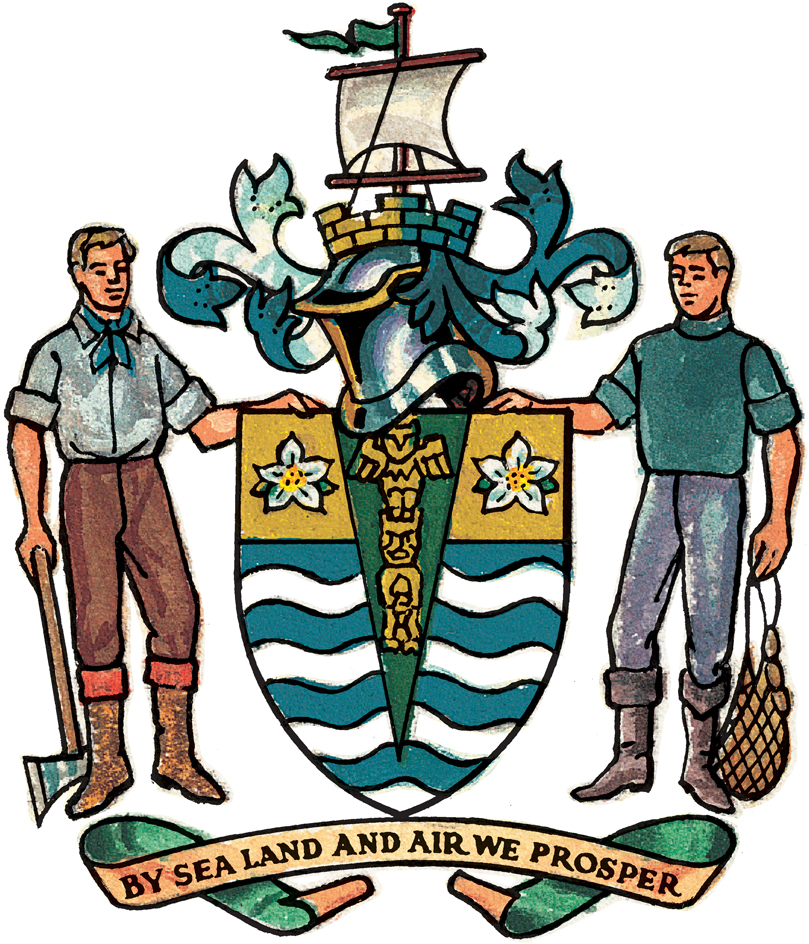
The great boom.
Between 1900 and 1910, job opportunities made Vancouver Canada’s fastest-growing city. The salmon-canning and wood-processing industries created many of these jobs. Immigrants poured into the city from China, India, Japan, the United Kingdom, and the United States. In 1904, the Great Northern Railway linked Vancouver with Seattle and other U.S. cities. By 1911, more than 100,000 people lived in Vancouver.
The opening of the Panama Canal in Central America in 1914 greatly increased business for Vancouver’s port. The canal provided a cheaper way to ship fish, grain, and lumber from western Canada to eastern North America and to Europe. By 1921, Vancouver had more than 117,000 people. In 1929, the neighboring communities of Point Grey and South Vancouver became part of Vancouver. In 1931, nearly 250,000 people lived in the city.
The middle and late 1900’s.
Vancouver suffered severely during the Great Depression of the 1930’s. Thousands of unemployed and homeless people moved to the city from other parts of Canada to seek jobs and relief from the cold winters. Many of these people found no work and took part in demonstrations against the provincial and federal governments.
World War II (1939-1945) brought prosperity to the city as shipbuilding and resource industries expanded. During the war, Vancouver served as headquarters of the coastal defense staffs of the Canadian Army.
The city changed rapidly after the war. Tall apartment buildings appeared in the West End, and modern office towers replaced old structures downtown. Shopping centers sprang up near many residential areas.
Vancouver’s seaport gained importance in the 1960’s because of a rapid growth of trade between Canada and Japan. In 1970, a coal-loading terminal equipped to handle the world’s largest cargo ships opened just south of Vancouver at Roberts Bank.
In the 1960’s and 1970’s, private developers erected more tall apartment buildings in the West End and office towers in the downtown area. Downtown developments included Pacific Centre and Royal Centre. Since the 1980’s, many new condominiums have gone up in downtown Vancouver. Also in the 1980’s, Canada Place was constructed on the Vancouver waterfront. This complex includes the World Trade Centre office building, a hotel, a convention center with a saillike roof, and docking facilities for cruise ships. Expo 86, an exposition of communication and transportation technologies, attracted over 22 million visitors to Vancouver in 1986.
Vancouver completed a number of major construction projects in 1995. These projects included Library Square, a new public library; General Motors Place, a sports arena now called Rogers Arena; and a new terminal for Vancouver International Airport.
Recent events.
Vancouver hosted the Winter Olympic Games in February 2010. The ski resort of Whistler, British Columbia, was the site of many of the events. Construction projects for the Olympic Games included athletes’ villages in downtown Vancouver and in Whistler, a rapid transit line, and a speed skating arena.
